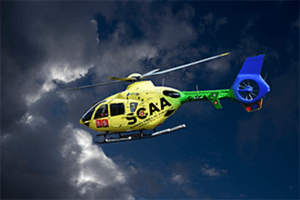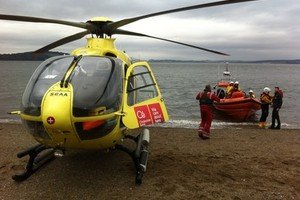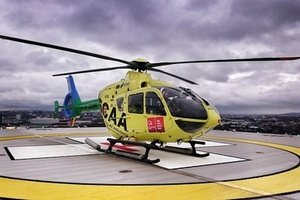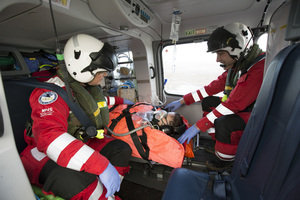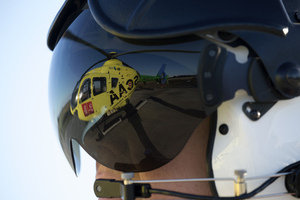
Winter Weather Challenges
Scotland is recognised as presenting some of the most challenging weather and terrain for helicopter air ambulance crews. Factor in winter, and a whole new set of challenges face our pilots and paramedics.
Severe weather, difficult terrain, deep snow, driving rain, high winds, blizzards, icy conditions, low cloud and plummeting temperatures all conspire in a bid to thwart our dedicated crews as they battle to reach the most seriously ill and injured throughout the winter months.
“We’ve got to be prepared for anything Scotland’s winter can throw at us,” said SCAA pilot Captain Pete Winn, “and that means constant vigilance and preparation.”
Based at SCAA’s Aberdeen Helimed 79 base, Pete is no stranger to tackling difficult missions to emergencies among Scotland’s mountain masses and remote communities. Winter, he says, just makes the job a little more challenging.
“We start by ensuring the crew, our kit and the aircraft are all ready for the shift ahead,” he explained. “This includes the crew briefing first thing in the morning where we look at everything that might affect our ability to respond or present challenges once airborne.”

Pete highlighted weather conditions and forecast as a priority.
“In Scotland, the weather can turn in an instant from mild open skies to grounding conditions and we have to stay abreast of changing weather systems at all times.”
Cloud levels and freezing levels can prove particularly troublesome and dodging heavy snow showers often sees the helicopter forced to take a circuitous route to reach or airlift a patient.
And even when on final appr oach at an emergency scene, danger can lurk in Scotland’s winter mantle.
“Soft deep snow could result in the helicopter sinking so we have to ensure any snowy surface is even, stable and secure,” said Pete. “Soft snow will also blow up around us as we approach, obscuring our view, so we have to be quite measured on our approach.
“We also have to be fairly sure what we’re landing on – a snow covering could be hiding untold dangers such as forest debris, deep ditches or rough boulders.”
Sinking into deep snow could damage the aircraft so pilots are always confident the snow covering is compact and secure before landing. And avalanche warnings are detailed in the morning briefing in case they have to attend accidents on the ski slopes or mountain areas.

“Icy surfaces are just as challenging,” said Pete. “If we attend a road traffic collision, for example, and the road surface appears icy and untreated, we will elect to land in a nearby field rather than the carriageway to avoid the risk of the aircraft sliding.”
Keeping warm in the air and at scene necessitates a few thermal layers for the crew beneath their uniforms and heavy jackets and warm hats on top.
“Long Johns are a must,” shared Pete. “The helicopter heating system is highly efficient when the engine is running but it soon cools down when we shut down at scene.”
The helicopter also carries a survival pack containing such essentials as a satellite phone, extra blankets, emergency high energy rations and water. While Pete and his fellow SCAA pilots are ensuring craft and crew can fly to and land safely at any incident, paramedics are preparing to face their own set of challenges that winter weather presents.
Helimed 79 paramedic Grace Aspden said that cold hands posed a problem for them as they work with patients in freezing conditions.
“Cold makes motor skills more difficult so every intervention we do becomes more challenging if our hands are freezing,” she said. “Snow means we get cold and wet which makes our job extra challenging.”
And the weather conditions affecting the paramedics are also affecting the patients.
“It’s vital to stop heat loss in your patient and we have to work fast to combat hypothermia which complicates any other condition,” said Grace.

Extra blankets and additional layers designed specifically to prevent heat loss are deployed.
“Once we get the patient into the aircraft and the engines start, we soon heat up,” explained Grace.
Helimed 76 at Perth also flies with an extreme weather kit on board, which includes a pop-up “bothy” to shelter both patient and paramedics from the elements and a special blizzard blanket for warmth. Protecting the patient from the harsh environment is critical until they can be prepared for flight.
“We’ve faced some testing times together,” said Pete, “and often we are working alongside colleagues such as Search and Rescue or Mountain Rescue Teams in the harshest of conditions to ensure the best outcome of the patient.
“It can prove demanding but there’s a great sense of satisfaction and relief when you deliver the patient to hospital and get the crew safely back to base,” he said. “Then it’s time for a cup of tea before we have to do it all again.”
